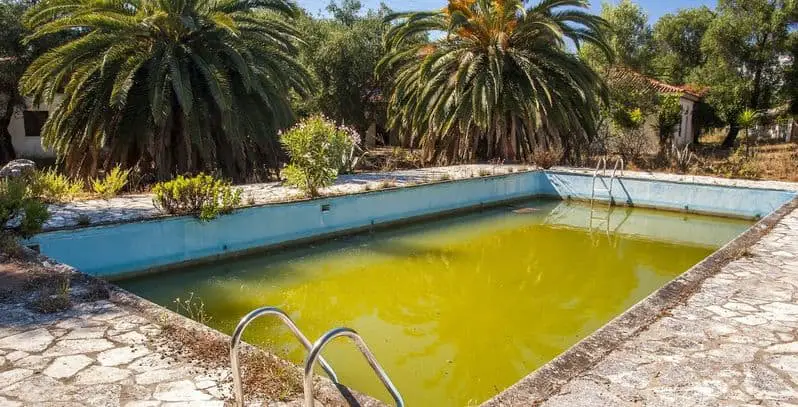
Brown pool water is not common, which means that either there is an impurity in the water or a chemical reaction with the impurity. Leaving it for a long time can stain your pool’s surface, make it even worse, difficult to remove, and permanent stains will be there.
Luckily, there is plenty you can do to win the battle against brown pool water and reclaim your pool. Here, we will show you how to get rid of brown pool water in just 6 steps. If you follow these steps, you can get rid of your pool problem in a few days.
What Causes Pool Water to Turn Brown?
There are many causes of brown water in a swimming pool. The most common cause of brown water is excessive organic material and oils that accumulate on the water surface. These materials can be tracked from outside sources and are also created within the pool environment.
The following is a list of potential reasons for brown water:
- High levels of metals in pool water like iron can create a similar appearance. Metal ions react with dissolved organic compounds in the water to form colored complexes. In this case, the pool would have a characteristic metallic or bitter taste and smell. Oxidized iron is the most common reason for metallic taste and discolored water in swimming pools.
To reduce the levels of metal ions that accumulate on the surface of a pool, sample the pool water every two weeks for metals and have an appropriate source (previously installed or properly sized cartridge filters) to filter out these contaminants from entering into your pool.
- Chlorine can react with organic material to create colored compounds within your swimming pool. This is more common if you have had recent problems with algae or if you are not chlorinating frequently enough.
- Excessive use of pool chemicals like chlorine and bromine can combine with organic material to create brown or yellow compounds in color. Stagnant water with a high level of debris is more likely to retain this discoloration.
- Incomplete removal of heavy metals, combined with chlorination and the presence of sunlight can cause black-colored sediments to appear on the surface of your pool. This is also known as “black algae”– although it has no plant life, it treats your swimming pool like a swamp, creating an unhealthy environment for swimmers and aquatic plants alike.
- Suspended material from the air or soil will sink to the bottom and form an oily layer as it decomposes, discoloring the water. This can come from leaves blowing into a pool or dirt and debris tracked in on people’s feet or animals like birds, raccoons, etc. Swimmers themselves also contribute significantly to this kind of contamination especially when they have lotion on their skin. This can be cleared by vacuuming the pool and skimming the surface very carefully to remove this floating layer.
- Nonfilterable material like certain types of algae can look brown or black in color. These should not be confused with stringy algae which float on the top and do not discolor the water. A brown film on top of a swimming pool usually indicates excessive nitrogenous organic compounds (NOCs). The most common cause is excess phosphate, possibly from using chlorine that contains high levels of residual phosphates or from excessive amounts of proteins washing into pools as a result of heavy swimmers using insufficient amounts of sanitizer or failing to properly maintain their equipment. It could also mean there is an imbalance between bacteria, algae, and cyanobacteria present.
- Salt water chlorination, which is very common in warmer climates and for commercial pools, can produce a brownish coloration on the surface of the pool due to excess oxidants (chlorine or its compounds). The solution is to dilute these oxidants with fresh water until you get a clear blue color again. Do not add more chemicals. This discoloration could also be caused by chlorine products that are unstable, stored improperly or made from substandard ingredients where there may be impurities already present. This type of nonfilterable discolorization occurs most often during periods when pH levels are low and sanitizer demand is high.
- Swimmers that sweat heavily are sometimes responsible for discoloration if they don’t shower before entering the pool, or maybe sweating out excess metals like copper which gets deposited on the surface of the pool or even silver from swimsuits made with these materials. This is more common when sodium bicarbonate (baking soda) is used as part of your chlorine sanitizer instead of calcium hypochlorite (cal hypo). Calcium hypochlorite is much less likely to cause brown stains on pool surfaces since it does not contain metal ions.
- The water may also appear brown when a swimmer has used a product like a suntan lotion, which is absorbed into the skin and then gets rinsed off in the pool. High levels of organic material can be introduced to pools through hot tubs, spas or saunas that are poorly maintained or cleaned regularly. It could come from accumulated oily body parts that fall into the water by swimmers themselves, animals like birds, raccoons, etc. There could also be leaf particles blown into the swimming pool, especially amidst trees/forest areas or grassy surroundings with foliage around it.
- Neglected or dirty pool filter. Without a clean filter to do its job properly, the water will turn brown from fine dirt particles settling at the bottom of the pool.
A combination of these reasons might lead to brown discoloration of your pool water.
Pool Algae Problems
Pool algae problems are usually caused by poor swimming pool water chemistry, pool maintenance, or bad filtration. Weekly pool maintenance is a must or you will be dealing with pool maintenance headaches.
How to find out what are the causes of brown pool water?
1. Looking for rusting metals or objects in the pool.
Check for disintegrating or rusting objects that could have been brought into your swimming pool.
This can include metal objects like a lost earring, a coin, or any other metallic object that fell off from someone in the pool and got left behind.
Check slide, pool ladder, and walls for rusting or flaking paint.
If you are certain that these items have been painted with top-quality paints, and the rust is coming from your pool water itself, check for the presence of rust-causing metals like iron in your pool filter sand and pump baskets.
2. Check your pool filter and pump components.
Are they rusting? Cleaned and replaced them if necessary.
If your filter’s sand is still clean, it should not be the cause of brown pool water. But check for disintegrating pipes or broken hoses that could have deposited rust or other iron/steel particles into the pool, which are also nonfilterable.
3. Collect samples from different areas in your swimming pool
Test with chemical kits(especially iron) provided by test kit shops or with an electronic tester.
Check the pH and chlorine level, and test for other elements like iron, copper, or manganese.
- ✔[ 16 IN 1 WATER TEST KIT] Hofun water test strips is equipped with 16 major function, including: PH, Mercury, Lead, Iron, Copper, Total Alkalinity, Hardness, Nitrite, Nitrate,Bromine, Free Chlorine, Total Chlorine , Fluride, Chromium/Cr,Carbonate Root,Cyanuric acid , helps you to have a clear mind of how clear and healthy your water is.
- ✔[ EXTRA ACCESSORIE & EASY OPERATION ] Hofun spa test kit is sweet enough to equip with dropper & test tube, which would avoid water pollution and make a convenient operation.
- ✔[ WIDE USAGE WATER TEST KIT ] Hofun 16 in 1 water test strips can be applied to a wide range of water inspection, like drinking water, pool, hot tub, spa, pond, aquarium, industrial waste water,etc.
- ✔[ THE MOST ACCURATE & SCIENTIFIC WATER TEST STRIPS] Hofun specializes in testing & measuring area for years and adopts the most reliable strips on our products to assure the accuracy of testing water quality.
- ✔[ PERFECT VALUE FOR YOUR MONEY ] - Hofun water testing kits for drinking water is absolutely economic, it will save you thousands of Dollar from send your water to lab to be tested. It’s also time-saving due to convenient operation.
- Strips will expire in 3 months after opening.
* As an Amazon Associate I earn from qualifying purchases.
Follow These Steps to Clear the Brown Pool Water
- Treat your pool with ascorbic acid, you won’t need more than a pound. The ascorbic acid should work within an hour or two. Wait for it to be circulated throughout the system.
- Once the brown stain has been lifted, turn off the pool pump temporarily.
- Spray a 16oz bottle of Revive over the top of the pool which will remove the iron particles and turn them into sediments to the bottom of the pool.
- Wait 24 hours until you use the pool.
- Vacuum the debris off the bottom of the pool while your filter is on the waste setting.
- You will want to continue to shock your pool weekly and follow the instruction on the package carefully.


